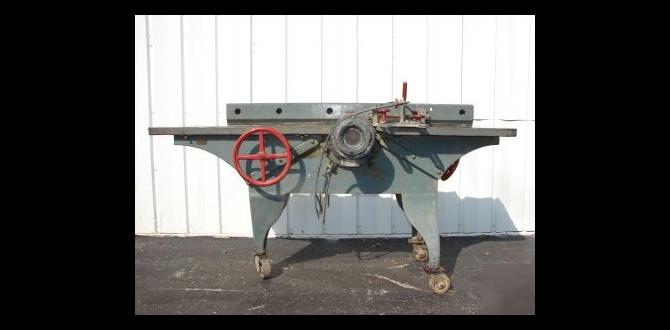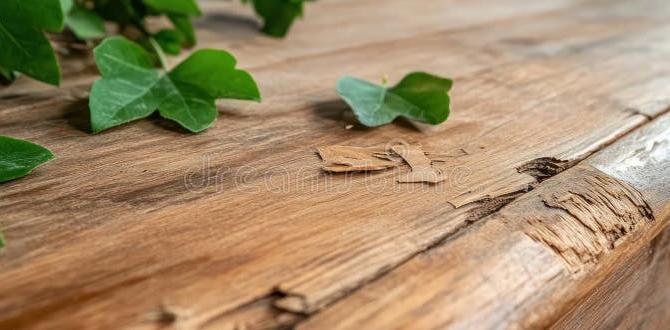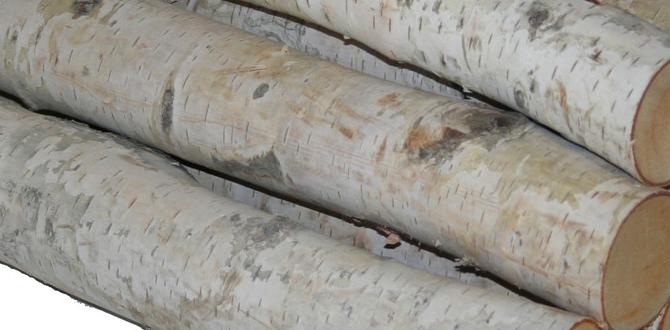Imagine you’re in a bright workshop, surrounded by wood and tools. You want to build something amazing, but you’re not sure which tool to pick. Should you reach for the joiner or the jointer? This is a question many woodworkers ask.
A joiner and a jointer sound similar, but they serve very different purposes. Did you know that a jointer helps you flatten and straighten wood, while a joiner connects pieces together? Choosing the right tool can make a big difference in your project.
Understanding these tools can save you time and effort. Have you ever struggled with uneven wood or crooked edges? Knowing when to use a joiner or a jointer can solve these issues. It can also turn a challenging task into a fun and enjoyable experience.
Join us as we explore joiner vs jointer. We’ll help you discover which tool best fits your woodworking needs. Get ready to take your skills to the next level!
Table of Contents
Joiner Vs Jointer: Which Tool Is Best For Your Woodworking Needs? In The World Of Woodworking, The Choice Of Tools Can Significantly Impact The Quality And Efficiency Of Your Projects. Among The Essential Machines That Every Woodworker Considers Are The Joiner And The Jointer. While The Names May Sound Similar, These Tools Serve Different Purposes And Are Designed For Specific Tasks. Understanding The Distinctions Between A Joiner And A Jointer Can Help You Make An Informed Decision About Which Tool Is Best Suited For Your Woodworking Needs. What Is A Joiner? A Joiner Is Primarily A Professional Carpentry Or Woodworking Expert Who Specializes In Creating Joints. This Term Can Also Refer To A Tool Used For Joining Pieces Of Wood Together. Joiners Work On Making Very Precise And Strong Connections Between Wood Pieces, Ensuring The Final Product Is Sturdy And Aesthetically Pleasing. They Often Focus On Projects Like Furniture Making, Where Intricate Wood Jointing Techniques Come Into Play. What Is A Jointer? A Jointer, On The Other Hand, Is A Woodworking Machine Used To Flatten And Smooth The Surface Of Wood. It’S Essential For Preparing Lumber That Needs To Be Joined Together. A Jointer Is Typically Used To Square One Edge Of A Board, Making It Ready For Further Operations Like Planing Or Joining With Another Piece Of Wood. If You Plan To Work With Rough Lumber, A Jointer Is Crucial For Achieving Flat Surfaces. Key Differences Between Joiner And Jointer 1. **Functionality**: – The Joiner Is Focused On Creating Connections Between Wood Pieces, While The Jointer Is Used For Flattening Wood Surfaces. 2. **Usage**: – Joiners Are Skilled Craftspeople, Whereas Jointers Are Machines That Assist In The Preparation Of Wood. 3. **Tools Required**: – Joiners May Need A Variety Of Hand Tools And Joinery Equipment (Like Doweling Jigs, Biscuit Joiners), While Jointers Require A Single Machine Designed For Smoothing Wood. Which Tool Is Best For Your Woodworking Needs? Choosing Between A Joiner And A Jointer Depends On Your Specific Woodworking Needs And The Projects You Intend To Tackle. If Your Focus Is On Fine Woodworking And Creating Complex Joints For Furniture, Investing Time In Learning Joinery Skills And Acquiring Joining Tools Would Be Beneficial. However, If You Are Working With Raw Lumber And Require Precision In Flattening And Preparing Wood Surfaces, A Jointer Is An Indispensable Tool. Conclusion In Summary, Both The Joiner And The Jointer Have Their Unique Roles In Woodworking. To Make The Best Choice For Your Projects, Consider The Type Of Work You Will Be Doing. Understanding The Differences Can Help You Invest Wisely In Tools That Enhance Your Woodworking Experience. Whether You Opt For A Joiner Or A Jointer, Mastering Their Use Can Elevate Your Craftsmanship To New Heights.

Joiner Vs Jointer: Which Tool is Best for Your Woodworking Needs?
Choosing between a joiner and a jointer can be tricky. A jointer smooths edges, making boards fit perfectly together. Meanwhile, a joiner helps you connect pieces, creating strong joint structures. Whether you’re building furniture or cabinets, understanding each tool’s function is key. Did you know a jointer can also flatten warped wood? This can save you time on projects. Think about your woodworking goals to decide which tool will best meet your needs!
Understanding the Basics of Joiners and Jointers
Definition and purpose of a joiner. Definition and purpose of a jointer.
A joiner is a woodworking tool or technique used to connect two pieces of wood. It helps create strong joints that keep the wood together. Joiners are great for making furniture, cabinets, and more. They come in various styles, like finger joints and mortise-and-tenon joints.
In contrast, a jointer is a machine that smooths and flattens the edges of wood. It prepares the wood for joining by making its surface even. This tool is essential for achieving a smooth finish before assembly.
What is the main difference between a joiner and a jointer?
The main difference lies in their functions. A joiner connects wood pieces, while a jointer prepares the wood before they can be joined.
Key Differences Between Joiners and Jointers
Functionality and design differences. Typical applications for each tool.
Joiners and jointers, while similar, serve different purposes. Joiners are tools for connecting pieces of wood, creating strong bonds. They help make corners and joints look neat. Jointers, on the other hand, flatten wood surfaces. They prepare the edges for smooth alignment. Here’s a quick comparison:
- Functionality: Joiners connect pieces; jointers flatten and straighten wood.
- Design: Joiners use clamps; jointers have long tables with blades.
- Typical Applications: Joiners are used in frame-making; jointers help with cabinet-making.
What are the main uses of a joiner and a jointer?
The main use of a joiner is to connect wooden parts securely. A jointer is used to make surfaces flat and ready for use.
Advantages of Using a Joiner
Benefits specific to woodworking projects. Impact on joinery techniques and craftsmanship.
Using a joiner in woodworking can be like having a magic wand. It creates smooth, flat surfaces on your wood. This makes your projects fit together perfectly. Good fit means strong joints, which keeps your furniture from falling apart. Plus, a joiner can help you show off your craftsmanship. With practice, your skills will shine like a polished apple! Imagine impressing friends with your work and leaving them wondering if you are secretly a woodworking wizard.
| Advantages of Using a Joiner |
|---|
| Smooth surfaces for better fit |
| Stronger joints in projects |
| Improved craftsmanship |
| Boosts woodworking skills |
With these benefits, a joiner can truly make a difference. Think about it: precise edges lead to neat projects! Plus, your next masterpiece might just win “Woodworking Superstar” at the local fair.
Advantages of Using a Jointer
Benefits for achieving flat surfaces and edges. Importance in preparing lumber for joinery.
A jointer is a fantastic tool for woodworkers. It helps you create flat surfaces and sharp edges. This is important because wood needs to fit together perfectly for strong joints. A jointer makes your wood look smooth and neat, allowing for better glue surfaces. Without it, your project may not come out as well. Here are some key benefits:
- Achieves flat surfaces.
- Creates straight edges.
- Prepares wood for joinery.
Why is a jointer important in woodworking?
Using a jointer is essential for quality projects. It lets you join multiple pieces of wood seamlessly. This ensures a strong bond and a professional finish. Using a jointer can improve your woodworking skills and results.
Choosing the Right Tool for Your Woodworking Project
Factors to consider when selecting between a joiner and jointer. Evaluating project requirements and tool capabilities.
Picking the right tool for your woodworking project can feel like solving a mystery. First, think about what your project needs. A joiner is great for smoothing and joining edges, while a jointer helps flatten surfaces. Check your project’s requirements and match them with what each tool offers. It’s like choosing between peanut butter and jelly: both tasty, but not always perfect together!
| Tool | Best for |
|---|---|
| Joiner | Joining edges smoothly |
| Jointer | Flattening surfaces |
Before choosing, ask yourself, “What do I need?” If you want to create strong joints, choose a joiner. If you need flat surfaces, go for a jointer. The right tool can make your woodworking dreams come true!
Cost Considerations: Joiners vs. Jointers
Price range analysis for each tool. Longterm investment and value considerations.
When comparing joiners and jointers, cost is key. Joiners often cost less, ranging from $50 to $300. Jointer prices start at around $200 and can go up to $1,000. Consider the long-term benefits, too. A quality jointer might seem pricey but offers better performance and durability. Investing in a strong tool can save money over time.
What is the best way to invest in woodworking tools?
Focus on quality over price. A reliable tool lasts longer and works better, helping you create amazing projects.
- Joiners: $50 – $300
- Jointers: $200 – $1,000
User Experiences and Reviews
Insights from woodworking professionals and enthusiasts. Common pitfalls and lessons learned when using each tool.
Woodworkers love to share their experiences, often filled with laughter and lessons. Many pros say that using a joiner is like making a friend with your wood. It helps create straight edges, but some found out the hard way that a dull blade can ruin the fun! Others enjoy their jointers for planning edges, but occasionally, they wrestle with setup. Just remember, “measure twice, cut once” is not just a saying; it’s a survival guide!
| Tool | User Experience | Pitfalls |
|---|---|---|
| Joiner | Create smooth edges | Dull blades can cause frustration |
| Jointer | Plan edges accurately | Setup may lead to headaches |
Maintenance and Care Tips
Best practices for maintaining joiners. Best practices for maintaining jointers.
Proper care keeps your tools in great shape. Here are some best practices:
- Clean your joiner and jointer after each use. Dust can damage them.
- Check the blades regularly. Sharp blades cut better and keep you safe.
- Lubricate moving parts to prevent rust. This helps them work smoothly.
- Store tools in a dry place. Moisture can cause damage over time.
- Follow the manufacturer’s instructions for maintenance. This ensures peak performance.
What are the best maintenance practices for joiners?
Keep your joiner clean, check for sharp blades, and ensure proper storage. Regular maintenance makes a big difference!
What are the best maintenance practices for jointers?
Regular lubrication and cleaning are key for jointers. This keeps them working optimally and extends their life.
Frequently Asked Questions (FAQ)
Common queries woodworking beginners have about joiners and jointers. Expert tips to help clarify confusion in tool selection.
Many beginners ask questions about joiners and jointers. Here are some common queries:
What is the main difference between a joiner and a jointer?
A joiner is a handheld tool for making joints, while a jointer is a larger machine used to flatten wood surfaces.
Which tool should I use for my project?
Choose a jointer for smoothing edges and a joiner for creating strong joints.
Can I use both tools together?
Yes! Using both can improve the quality of your woodworking.
- Use a jointer first to flatten your wood.
- Then, use a joiner to connect pieces securely.
These tips will help simplify your tool choices.
Conclusion
In conclusion, both joiners and jointers serve important roles in woodworking. Joiners are great for making strong connections between pieces. Jointer tools help smooth and flatten wood surfaces. Decide which tool fits your projects best. Consider your needs, budget, and skills. For more help, check woodworking websites or ask a local expert. Happy woodworking!
FAQs
What Are The Primary Functions Of A Joiner And A Jointer In Woodworking Projects?
A joiner helps us connect two pieces of wood together, making strong joints. It makes sure the edges fit perfectly. A jointer flattens one side of a piece of wood and makes it smooth. This way, our projects look nice and fit well together. Both tools help us build stronger and prettier things out of wood.
In What Situations Would A Woodworker Prefer To Use A Joiner Over A Jointer, And Vice Versa?
Woodworkers choose a joiner when they want to make strong wood joints for furniture. A jointer is better for flattening rough wood surfaces before cutting. If you need to join two pieces of wood tightly, use a joiner. If your wood is uneven, a jointer helps make it flat. Each tool has its special job!
How Do The Cutting Mechanisms Of Joiners And Jointers Differ, And How Does This Affect The Final Finish Of The Wood?
Joiners and jointers cut wood differently. A jointer smooths the edges and makes them flat. You use it to prepare the wood for joining. A joiner connects two pieces of wood together. Because of these differences, wood from a jointer looks very smooth, while joiner work is strong but may need extra finishing.
What Are The Key Features And Specifications To Look For When Choosing Between A Joiner And A Jointer?
When choosing between a joiner and a jointer, you should think about how you want to use it. A jointer helps you make flat edges on wood. Look for the width of the table and how powerful the motor is. A joiner, on the other hand, is used for connecting pieces of wood together. Check the types of joints it can make and how easy it is to use.
Are There Specific Types Of Woodworking Projects That Are Better Suited For One Tool Over The Other, And If So, What Are They?
Yes, some woodworking projects are better for certain tools. For example, if you want to cut wood quickly, a saw is best. If you need to smooth the edges, a sander works well. When joining pieces, a drill is great for making holes. Each tool helps us do different tasks better!







